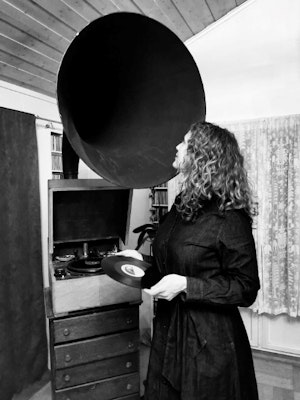Field of study: Artistic Research (Vocal)
Ingeborg Dalheim: Back out of the gramophone

In this project, the soprano Ingeborg Dalheim explores listening as a method of learning in classical singing.
Summary
By listening to recordings of Norwegian classical singers from the early 20th century, Dalheim will adopt stylistic and technical elements, and try to understand the underlying esthetic preferences of the era. To ensure a true learning by ear, she will not use the musical scores while learning the songs. The repertoire recorded in this «acoustic period», a name referring to the mechanical recording methods used, consists largely of songs by the Norwegian composers Edvard Grieg and Halvdan Kjerulf, and include a recording of Edvard Grieg’s wife, Nina Grieg, singing the first lines of «Solveig’s song», which can be seen as a strongly authoritative interpretation of one of Grieg’s greatest hits. Dalheim will seek to «complete» this recording in the style of Nina Grieg and her contemporaries.
Tool traces
Through thorough and repeated listening to recordings, more details appear, and the brain is capable of eliminating noise and other irrelevant sounds. Gradually, a stylistically conscious artist appears, with passion and artistic intention. And behind this, other sounds represent tiny traces of the person singing in front of the tapered horn of the recording device. When copying or reconstructing old artifacts, craftsmen often look for traces of the tools originally used to produce the artifact, to learn more about the manufacturing process. Attentive listening may expose similar «tool traces», like breathing sounds or text pronunciation, that can give the listener some hints regarding the singer’s posture or facial expressions, and can serve as an aid for the modern singer to leave the «comfort zone» and reenact the original recording.
Do you hear what I hear?
The pianist Heloisa Amaral is an essential collaborator for the project, and will also learn the repertoire by ear. Together, Dalheim and Amaral will utilize learning by listening in a chamber music setting, and explore how the musician relates to the music with no musical score present. How does the absence of a musical score affect the performer’s role and relation to the composer’s intention? How are the musical processes changed when the musicians relate to their own, subjective memory?
Recording for eternity
Recording music is fundamentally different from performing live music, and demands a different set of competences from the musician. For the early 20th century singers, the concept of freezing time in a recording was mindblowingly new and unknown, and the recording situation itself was demanding; the singer had to sing into a tapered horn, with the pianist situated out of sight, behind the singer on a platform. The singer also had to avoid variation in dynamic range, and it was impossible to edit the recording afterwards. How does the singer actually sing well under these demanding circumstances, and how does a singer relate to the performing aspects with no audience present? How does the concept of recording something for eternity affect a singer, and what are the differences between the recording and a live concert of the same repertoire?
Woman and gramophone star
Surveying the variation in vocal resonance and dramatic expressions the recordings present, Dalheim will research the limitations put upon female singers by the society, and themselves, in their performances and artistic practices. Is today’s conservative classical singing tradition still under the influence of these or other expectations concerning femininity on stage and on record?
The project will include recordings on original equipment, which will serve as important calibration tools for the continued work to get as close to the sources as possible and walk back out of the gramophone.
Articles relevant
Published: Oct 15, 2021 — Last updated: Nov 1, 2024

